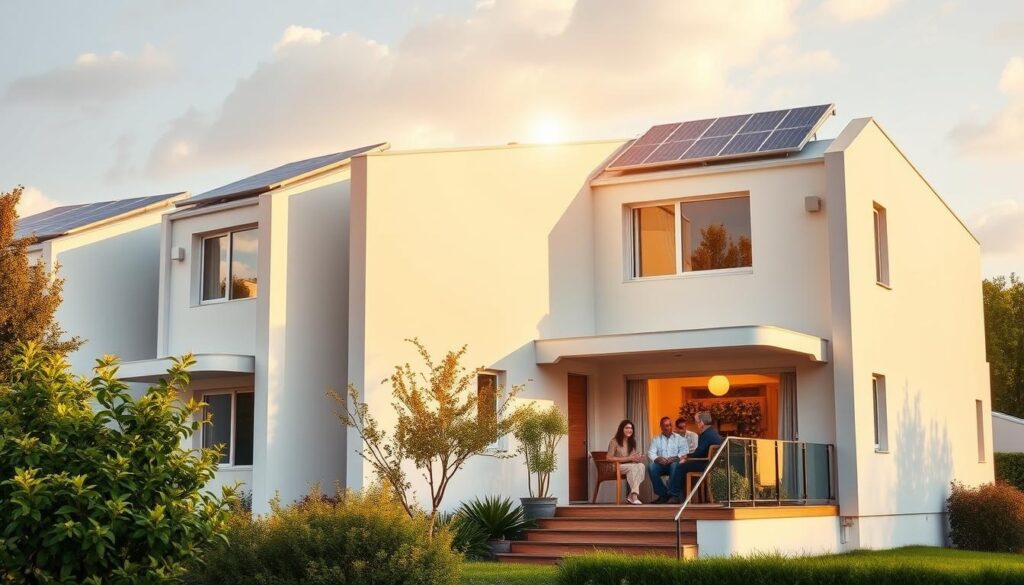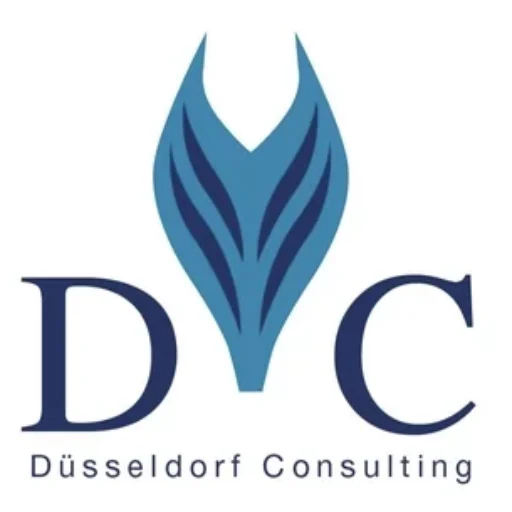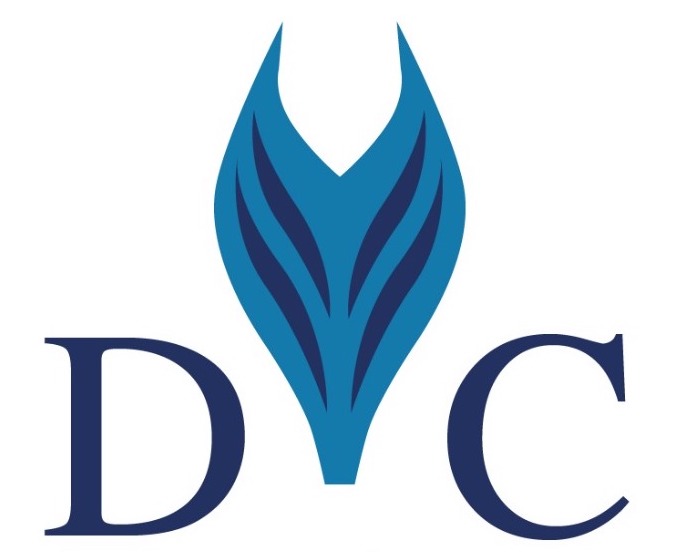The concept of Passive Houses has revolutionized the construction industry, particularly in Germany, where it originated. This innovative approach focuses on creating energy-efficient and eco-friendly homes that significantly reduce carbon emissions.
Carbon-neutral homes are becoming increasingly popular worldwide, and Germany is at the forefront of this movement. Passive House integrators play a crucial role in designing and building these sustainable homes, utilizing cutting-edge techniques and materials to minimize environmental impact.
Key Takeaways
- Passive Houses originated in Germany and are gaining global popularity.
- Carbon-neutral homes reduce carbon emissions and promote sustainability.
- Passive House integrators are crucial in designing and building eco-friendly homes.
- Germany is a leader in the adoption of Passive House technology.
- Sustainable construction practices are on the rise.
Understanding Passive House Concept
The concept of Passive House has revolutionized the way we think about energy-efficient homes. It’s a building standard that is designed to be extremely energy-efficient and comfortable, using minimal energy for heating and cooling.
Definition of Passive House
A Passive House is defined by its ability to maintain a comfortable indoor climate without the need for conventional heating and cooling systems. This is achieved through a combination of design elements, including super-insulation, high-performance windows, and airtight construction.
Key Features of Passive Houses
Some of the key features of Passive Houses include:
- High levels of insulation to minimize heat loss
- Triple-glazed windows for optimal energy efficiency
- Airtight construction to prevent heat escape
- Mechanical ventilation systems with heat recovery
For more information on building standards in Germany, you can refer to this guide on green building standards.
Benefits of Passive House Living
Living in a Passive House offers numerous benefits, including reduced energy consumption, lower utility bills, and a healthier indoor environment. By minimizing the need for heating and cooling, Passive Houses also contribute to a reduction in carbon emissions, making them an attractive option for those looking to reduce their environmental footprint.
Overview of Carbon-Neutral Building
As the world shifts towards sustainable living, carbon-neutral building has become a crucial aspect of modern construction. This approach to building design and construction focuses on reducing the environmental impact of buildings by minimizing their carbon footprint.
Carbon-neutral buildings are designed to produce no net greenhouse gas emissions, using renewable energy sources and energy-efficient technologies. The importance of carbon-neutral building lies in its potential to significantly reduce the overall carbon emissions associated with the building sector.
Definition and Importance
Carbon-neutral building refers to the practice of creating buildings that have a neutral impact on the environment in terms of greenhouse gas emissions. This is achieved through a combination of energy-efficient design, the use of renewable energy sources, and the implementation of sustainable building practices.
The importance of carbon-neutral building cannot be overstated. Buildings are among the largest consumers of energy and emitters of greenhouse gases. By adopting carbon-neutral building practices, we can significantly reduce the environmental impact of the building sector.
Strategies for Achieving Carbon Neutrality
Achieving carbon neutrality in buildings involves several key strategies:
- Energy-efficient design: This includes optimizing building orientation, insulation, and window placement to minimize energy consumption.
- Renewable energy integration: Incorporating renewable energy sources such as solar, wind, and geothermal energy to power buildings.
- Sustainable materials: Using materials that are sustainably sourced, have low embodied energy, and can be recycled or reused.
- Smart building technologies: Implementing technologies that optimize energy use, such as smart grids and energy management systems.
By adopting these strategies, buildings can significantly reduce their carbon footprint and contribute to a more sustainable future.
The Role of Passive House Integrators
With their deep understanding of Passive House principles, integrators are revolutionizing the way homes are built in Germany. Passive House integrators specialize in designing and building homes that are not only energy-efficient but also comfortable, utilizing innovative building design and low carbon footprint solutions.
What Do They Do?
Passive House integrators are responsible for ensuring that homes are built to the highest standards of energy efficiency. They achieve this through meticulous planning and the use of advanced materials and techniques. Their tasks include:
- Designing homes that minimize energy consumption
- Selecting materials that are sustainable and have low environmental impact
- Implementing construction methods that reduce waste and energy use
- Conducting thorough inspections to ensure compliance with Passive House standards
By focusing on these areas, integrators can significantly reduce the carbon footprint of homes, making them more environmentally friendly.
Why Choose an Integrator?
Choosing a Passive House integrator for your building project offers numerous benefits. These professionals have the expertise to ensure that your home is not only compliant with Passive House standards but also optimized for energy efficiency and comfort. Some of the key advantages include:
| Benefit | Description |
|---|---|
| Energy Efficiency | Homes built by integrators consume significantly less energy, reducing utility bills. |
| Comfort | Advanced insulation and design ensure a consistent and comfortable indoor climate. |
| Sustainability | The use of sustainable materials and practices minimizes environmental impact. |
As shown in the table, working with a Passive House integrator can lead to substantial benefits in terms of energy efficiency, comfort, and sustainability.
In conclusion, Passive House integrators play a vital role in the construction of carbon-neutral homes in Germany. Their expertise in innovative building design and low carbon footprint solutions is crucial for achieving the high standards required by the Passive House certification.
Differences Between Passive House and Traditional Construction
Passive House construction has emerged as a highly energy-efficient alternative to traditional building methods. This difference is not just about the materials used but also about the overall approach to building design and functionality.
Energy Efficiency Comparisons
One of the most significant differences between Passive House and traditional construction lies in their energy efficiency. Passive Houses are designed to be highly energy-efficient, using advanced insulation and window technologies to minimize heat loss during winter and heat gain during summer. In contrast, traditional construction methods often result in higher energy consumption due to less effective insulation and older window technologies.
Energy efficiency is achieved through meticulous planning and the use of high-performance materials. For instance, Passive Houses typically use triple-glazed windows and advanced insulation materials that significantly reduce the need for heating and cooling.

Cost Implications
While the initial investment in Passive House construction can be higher than traditional construction, the long-term cost savings are substantial. Reduced energy consumption translates into lower utility bills, providing homeowners with significant savings over the life of the building.
A comparison of the cost implications reveals that although Passive House construction may have higher upfront costs, the return on investment is considerable when factoring in the energy savings and potentially lower maintenance costs due to the high-quality materials used.
The Impact of Passive House on the Environment
Climate-friendly architecture is at the heart of the Passive House concept, offering numerous environmental benefits. The design and construction of Passive Houses are centered around minimizing environmental impact while maximizing energy efficiency.
Reduced Energy Consumption
One of the primary advantages of Passive Houses is their significantly reduced energy consumption. This is achieved through a combination of advanced insulation techniques, high-performance windows, and airtight construction. As a result, Passive Houses require less energy for heating and cooling, reducing the overall demand on energy resources.
The table below highlights the differences in energy consumption between Passive Houses and traditional buildings:
| Building Type | Energy Consumption (kWh/m²/year) |
|---|---|
| Passive House | 15 |
| Traditional Building | 150 |
Lower Carbon Footprint
In addition to reduced energy consumption, Passive Houses also have a lower carbon footprint. This is due to the reduced need for fossil fuels and the incorporation of renewable energy sources. By minimizing reliance on non-renewable energy, Passive Houses contribute less to greenhouse gas emissions, making them a more sustainable option.
The environmental benefits of Passive Houses are multifaceted, ranging from reduced energy consumption to a lower carbon footprint. As the world moves towards more eco-friendly buildings and climate-friendly architecture, the role of Passive Houses will become increasingly important.
Regulations and Standards in Germany
In Germany, building codes and regulations play a crucial role in promoting sustainable construction practices, such as the Passive House concept. The country’s commitment to reducing carbon emissions is reflected in its rigorous building codes, which support energy-efficient construction and the integration of green building technology.
Overview of Building Codes
Germany’s building codes are designed to minimize energy consumption and promote sustainable building practices. The codes are regularly updated to reflect the latest advancements in energy-efficient construction. For instance, the Energy Saving Ordinance (EnEV) sets standards for energy efficiency in buildings, while the Renewable Energies Act (EEG) promotes the use of renewable energy sources.
Passive House Certification Process
The Passive House certification process is a rigorous evaluation that ensures buildings meet the high standards of energy efficiency and sustainability. To achieve certification, buildings must demonstrate exceptional performance in terms of energy consumption, airtightness, and thermal comfort. The certification process involves a detailed assessment of the building’s design, construction, and performance, including its integration of renewable energy integration.
As noted by the Passive House Institute, “The certification is a guarantee that the building has been designed and constructed to the highest standards of energy efficiency and sustainability.” This rigorous process ensures that certified buildings are not only environmentally friendly but also provide a healthy and comfortable living space for occupants.
Popular Passive House Integrators in Germany
Passive House integrators in Germany are at the forefront of sustainable building practices, offering cutting-edge solutions for carbon-neutral homes. These integrators play a crucial role in promoting energy efficiency and reducing carbon emissions through innovative building design.
Leading Companies in the Sector
Several leading companies in Germany specialize in Passive House construction, providing a range of services from design to completion. Some of the notable companies include:
- Passivhaus Institut: Renowned for its rigorous standards and certification processes, ensuring high-quality Passive House constructions.
- PHI Darmstadt: A pioneer in Passive House research and development, offering expertise in energy-efficient building solutions.
- Other prominent companies like ProPeller and IG Passivhaus are also making significant contributions to the sector.
These companies are driving the adoption of Passive House standards across Germany, promoting sustainable building practices and reducing environmental impact.
Case Studies of Notable Projects
Several notable projects in Germany showcase the effectiveness of Passive House integration. For instance:
- A residential complex in Berlin achieved significant energy savings through the use of advanced insulation and window technologies.
- A Passive House development in Munich demonstrated the feasibility of carbon-neutral living, with homes that produced more energy than they consumed.
These case studies highlight the potential of Passive House integrators to create sustainable, energy-efficient homes that contribute to a cleaner environment.
By adopting innovative building design and energy-efficient technologies, Passive House integrators in Germany are setting a new standard for sustainable construction practices.
The Future of Passive House and Carbon-Neutral Buildings
With the growing emphasis on environmental sustainability, Passive House and carbon-neutral buildings are set to revolutionize the construction industry. As concerns about climate change and energy efficiency continue to grow, the adoption of sustainable building practices is becoming more widespread.

Trends in Sustainable Construction
The trend towards sustainable construction is driven by several factors, including government regulations, technological advancements, and changing consumer preferences. One of the key trends is the increasing use of renewable energy sources in building design, such as solar and wind power, to reduce reliance on fossil fuels.
Another significant trend is the adoption of green building materials and practices that minimize environmental impact. This includes the use of recycled materials, sustainable wood products, and low-VOC (Volatile Organic Compound) paints.
“The future of construction is not just about building houses; it’s about creating sustainable communities that thrive for generations to come.”
Innovations in Passive House Design
Innovations in Passive House design are continually evolving, with a focus on improving energy efficiency and reducing carbon footprint. One of the key innovations is the development of advanced insulation materials and techniques that minimize heat loss and maintain a consistent indoor climate.
Additionally, the integration of smart home technologies into Passive House designs is becoming more prevalent. These technologies allow for real-time monitoring and control of energy usage, enhancing the overall efficiency of the building.
| Innovation | Description | Benefit |
|---|---|---|
| Advanced Insulation | New materials and techniques for better thermal performance | Reduced energy consumption |
| Smart Home Technologies | Real-time monitoring and control of energy usage | Enhanced energy efficiency |
| Renewable Energy Systems | Integration of solar, wind, and other renewable energy sources | Lower carbon footprint |
The future of Passive House and carbon-neutral buildings looks promising, driven by trends in sustainable construction and innovations in Passive House design. As the industry continues to evolve, we can expect to see even more efficient and environmentally friendly building practices emerge.
Financing and Incentives for Passive House Projects
Germany offers a range of financing options and incentives for sustainable construction projects, including Passive Houses. The country’s commitment to reducing carbon emissions has led to the development of various programs aimed at supporting the construction of energy-efficient homes.
Government Programs in Germany
The German government has established several initiatives to promote the development of Passive Houses. One of the key programs is the KfW (Kreditanstalt für Wiederaufbau) funding, which provides financial support for energy-efficient construction projects. The KfW offers low-interest loans and grants to homeowners and builders who meet specific energy efficiency standards.
Another significant government program is the Bafa (Bundesamt für Wirtschaft und Ausfuhrkontrolle) funding for energy-efficient buildings. This program provides subsidies for consulting services, energy audits, and the implementation of energy-efficient measures in buildings.
| Program | Description | Benefits |
|---|---|---|
| KfW Funding | Low-interest loans for energy-efficient construction | Reduces upfront costs, promotes energy efficiency |
| Bafa Funding | Subsidies for energy-efficient measures and consulting | Supports energy audits, promotes sustainable building practices |
Private Financing Options
In addition to government programs, private financing options are available for Passive House projects in Germany. Several banks and financial institutions offer specialized loans for sustainable construction. These loans often come with favorable terms, such as lower interest rates or longer repayment periods.
Private investors and crowdfunding platforms also play a role in financing Passive House projects. These alternatives can provide additional funding sources for developers and homeowners looking to invest in sustainable construction.
The combination of government programs and private financing options makes it more feasible for individuals and companies to invest in Passive House projects, contributing to Germany’s goals for reducing carbon emissions and promoting sustainable construction.
Challenges in Building Carbon-Neutral Homes
Despite the benefits, building carbon-neutral homes presents several challenges that need to be addressed. The construction industry is one of the largest consumers of resources and energy, making the transition to carbon-neutral buildings a complex task.
Common Obstacles Faced
Several obstacles hinder the widespread adoption of carbon-neutral homes. These include:
- High Initial Costs: The initial investment required for materials and technologies that support carbon-neutral construction is often higher than traditional methods.
- Lack of Skilled Labor: There’s a shortage of professionals with the necessary expertise to design and build energy-efficient homes.
- Regulatory Barriers: Existing building codes and regulations may not support or may even hinder the adoption of new, sustainable building practices.
- Public Awareness: Many potential homeowners are not fully aware of the benefits of carbon-neutral homes or may be deterred by the higher upfront costs.
Solutions and Best Practices
To overcome these challenges, several solutions and best practices can be employed:
- Incentivizing Sustainable Practices: Governments and private organizations can offer incentives for builders and homeowners who adopt carbon-neutral building practices.
- Education and Training: Providing education and training for builders and contractors on the latest sustainable building techniques can help address the shortage of skilled labor.
- Advancements in Technology: Continuing to innovate and improve building materials and technologies can reduce costs and increase efficiency.
- Streamlining Regulations: Updating building codes and regulations to support sustainable building practices can facilitate the adoption of carbon-neutral homes.
By understanding the challenges and implementing these solutions, the construction industry can move closer to achieving the goal of carbon-neutral homes.
Community Impact of Carbon-Neutral Buildings
Carbon-neutral buildings are at the forefront of enhancing local sustainability and community well-being. These structures not only reduce environmental impact but also foster a sense of community through their design and functionality.
Enhancing Local Sustainability
Eco-friendly buildings play a crucial role in promoting sustainability within local communities. By incorporating green technologies and materials, these buildings significantly reduce their carbon footprint. Some key benefits include:
- Reduced Energy Consumption: Energy-efficient systems lower the overall energy usage.
- Lower Operational Costs: Sustainable materials and designs reduce maintenance and operational expenses.
- Increased Property Value: Eco-friendly buildings often see an increase in property value, benefiting homeowners and investors alike.
Moreover, the adoption of climate-friendly architecture encourages a cultural shift towards sustainability. It inspires community members to adopt greener practices in their daily lives, further amplifying the positive impact.
Educating Homeowners and Builders
One of the significant advantages of carbon-neutral buildings is their potential to educate both homeowners and builders about sustainable practices. Workshops, seminars, and guided tours can be organized to:
- Demonstrate the benefits and feasibility of eco-friendly construction.
- Share knowledge on sustainable materials and energy-efficient technologies.
- Encourage the adoption of green building practices in future projects.
By educating stakeholders, we can create a ripple effect that promotes sustainability beyond individual buildings, contributing to a more environmentally conscious community.
In conclusion, carbon-neutral buildings are not just structures; they are catalysts for community change, promoting a healthier environment and fostering a culture of sustainability.
Resources for Further Learning
For those interested in delving deeper into the world of Passive House construction and green building technology, numerous resources are available to facilitate further learning.
Recommended Readings and Websites
Several publications and online platforms offer valuable insights into sustainable building practices. The Passive House Institute (passivehouse.com) is a leading resource, providing comprehensive information on Passive House design, construction, and certification. Additionally, websites like greenbuildingadvisor.com offer expert advice on green building technology and energy-efficient construction methods.
Industry Organizations and Networking Opportunities
Engaging with industry organizations can provide opportunities for networking and professional development. The International Passive House Association (passivehouse-international.org) is a prominent organization that promotes Passive House standards globally. By connecting with such organizations, individuals can stay updated on the latest trends and innovations in green building technology.
FAQ
What is a Passive House, and how does it achieve energy efficiency?
A Passive House is a building that is designed to be extremely energy-efficient, using advanced insulation, airtight construction, and optimized window placement to minimize heat loss. This results in a significant reduction in energy consumption and lower heating costs.
What are the benefits of living in a Passive House?
Living in a Passive House offers numerous benefits, including reduced energy bills, improved indoor air quality, and a lower carbon footprint. Additionally, Passive Houses are designed to be comfortable and quiet, with a consistent indoor temperature and reduced outside noise.
How do Passive House integrators contribute to building carbon-neutral homes?
Passive House integrators play a crucial role in designing and building carbon-neutral homes by providing expertise in energy-efficient construction, green building technology, and renewable energy integration. They help to ensure that buildings meet the high standards of the Passive House certification process.
What are the key differences between Passive House construction and traditional construction methods?
The main differences between Passive House construction and traditional construction methods lie in their approaches to energy efficiency and building design. Passive House construction prioritizes energy efficiency, using advanced materials and techniques to minimize energy consumption, whereas traditional construction methods often focus on minimizing upfront costs.
What regulations and standards apply to Passive House construction in Germany?
In Germany, Passive House construction is subject to various regulations and standards, including building codes and the Passive House certification process. These regulations ensure that buildings meet specific energy efficiency and sustainability standards, and they provide a framework for builders to follow.
What financing options are available for Passive House projects in Germany?
In Germany, various financing options are available for Passive House projects, including government programs and private financing options. These programs provide incentives for builders to invest in energy-efficient construction and green building technology.
What are the environmental benefits of Passive Houses, and how do they contribute to mitigating climate change?
Passive Houses offer numerous environmental benefits, including reduced energy consumption, lower carbon footprint, and improved indoor air quality. By reducing energy consumption and greenhouse gas emissions, Passive Houses contribute to mitigating climate change and promoting sustainable construction practices.
What are some common challenges faced in building carbon-neutral homes, and how can they be overcome?
Building carbon-neutral homes can be challenging due to factors such as higher upfront costs, complex building design requirements, and the need for specialized expertise. However, these challenges can be overcome by working with experienced Passive House integrators, using advanced building materials and techniques, and accessing financing options and incentives.
How can Passive House construction enhance local sustainability and promote climate-friendly architecture?
Passive House construction can enhance local sustainability by reducing energy consumption and greenhouse gas emissions, promoting eco-friendly buildings, and supporting climate-friendly architecture. By adopting Passive House principles, builders can create homes that not only minimize environmental impact but also provide healthy, comfortable living spaces.
Where can I find resources for further learning about Passive House construction and green building technology?
Resources for further learning about Passive House construction and green building technology can be found through industry organizations, online courses, and recommended readings. Networking opportunities with experienced builders and Passive House integrators can also provide valuable insights and expertise.




